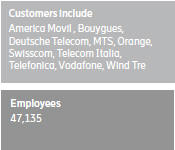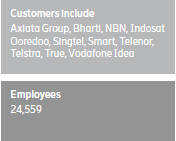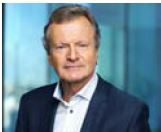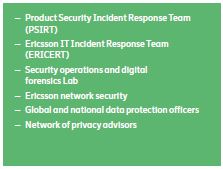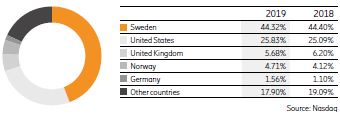Note A2, cont’d.
Judgments made in relation to accounting policies applied
Management applies judgment when assessing the customer’s ability and intention to pay in a contract. The assessment is based on the latest customer credit standing and the customer’s past payment history. This assessment may change during the contract execution, and if there is evidence of deterioration in the customer’s ability or intention to pay, then under IFRS 15 no further revenue shall be recognized until the collectability criteria is met. Conversely, this assessment may also change favorably over time, upon which revenue shall now be recognized on a contract that did not initially meet the collectability criteria.
Revenue for standard products shall be recognized when control over the equipment is transferred to the customer at a point in time. This assessment shall be viewed from a customer’s perspective considering indicators such as transfer of titles and risks, customer acceptance, physical possession, and billing rights. Judgment may be applied in determining whether risk and rewards have been transferred to the customer and whether the customer has accepted the products. In a sale of software license, judgment may also be applied to determine when the software is made available to the customer by considering when they can direct the use of, and obtain substantially all the benefits of, the license. Often all indicators of transfer of control are assessed together and an overall judgment formed as to when transfer of control has occurred in a customer contract.
Revenue for customized solutions shall be recognized over time if progress of completion can be reliably measured and enforceable right to payment exists over the duration of the contract. The progress of completion is estimated by reference to the output delivered such as achievement of contract milestones and customer acceptance. Judgment are applied when determining the appropriate revenue milestones that best reflect the progress of completion and are aligned with key acceptance stages within the contract.
Customer contract related balances
Key sources of estimation uncertainty
The Company monitors the financial stability of its customers, the environments in which they operate and historical credit losses. This is combined with expectations of future economic conditions to calculate expected credit losses (ECLs). ECLs on trade receivables and contract assets are assessed using a provision matrix based on days past due for groupings of customers that have historically had similar loss patterns. The amount of ECLs is sensitive to changes in the circumstances of our customers and the environments in which they operate as well as management’s expectations of future economic conditions. Actual credit losses may be higher or lower than expected. Total allowances for expected credit losses as of December 31, 2019 were SEK 3.0 (4.1) billion or 5% (6%) of gross trade receivables and contract assets. For further detailed information see note F1, “Financial risk management”.
Customer financing assets are valued at fair value on an individual basis. When market pricing is not available, an internal valuation model is applied considering external credit rating, political and commercial risks and bank pricing. Regular monitoring of customer behavior is also a part of the internal assessment.
In 2017, as part of the impairment assessment on receivables, the Company also monitored the financial stability of its customers and the environment in which they operate to make estimates regarding the likelihood that the individual receivables will be paid. Allowances are recorded for estimated losses on each individual receivable
Inventory valuation
Key sources of estimation uncertainty
Inventories are valued at the lower of cost and net realizable value. Estimates are required in relation to forecasted sales volumes and inventory balances. In situations where excess inventory balances are identified, estimates of net realizable values for the excess volumes are made. Inventory allowances for estimated losses as of December 31, 2019, amounted to SEK 3.4 (2.6) billion or 10% (8%) of gross inventory. For further detailed information, see note B5, “Inventories.”
Acquired intellectual property rights and other intangible assets, including goodwill
Key sources of estimation uncertainty
At initial recognition, future cash flows are estimated, to ensure that the initial carrying values do not exceed the expected discounted cash flows for the items of this type of assets. After initial recognition, impairment testing is performed whenever there is an indication of
impairment, in addition goodwill impairment testing is performed once per year. Negative deviations in actual cash flows compared to estimated cash flows as well as new estimates that indicate lower future cash flows might result in recognition of impairment charges. Write-downs for intangible assets and goodwill amounted to SEK 0.0 (0.5) billion for 2019. For 2017 impairment charges of SEK 17.2 billion were recognized.
At December 31, 2019, the amount of acquired intellectual property rights and other intangible assets amounted to SEK 33.7 (33.5) billion, including goodwill of SEK 31.2 (30.0) billion.
For further discussion on goodwill, see note A1, “Significant accounting policies”. Estimates related to acquired intangible assets are based on similar assumptions and risks as for goodwill. For more information, see note C1, “Intangible assets.”
Judgments made in relation to accounting policies applied
At initial recognition and subsequent remeasurement, management judgments are made, both for key assumptions and regarding impairment indicators. In the purchase price allocation made for each acquisition, the purchase price is assigned to the identifiable assets, liabilities and contingent liabilities based on fair values for these assets. Any remaining excess value is reported as goodwill.
This allocation requires management judgment as well as the definition of cash-generating units for impairment testing purposes. Other judgments might result in significantly different results and financial position in the future.
Leases
Key sources of estimation uncertainty
At initial recognition and subsequent remeasurement, management estimates are made for the term applied in a lease contract. The outcome of these estimates may turn out not to match the actual outcome of the lease and may have an adverse effect on theright-of-use assets. For more information, see note C3, “Leases.”
Judgments made in relation to accounting policies applied
Lease contracts may give the lessee the right to shorten or prolong a contract. Under such contracts management judgement of the lease term is required
Provisions
Key sources of estimation uncertainty
Provisions are mainly related to estimates for onerous contracts with customers and suppliers. Onerous customer contract provision includes estimate of costs to be incurred based on the latest conditions and progress on the contract. Assumptions on the probable outcomes of revenue and costs, which may include costs of potential compensation or penalties on exit, are revised regularly based on latest available information and the provision remeasured accordingly. Other sources for estimation uncertainty are restructuring program execution, patent and other litigations. As commented above in the initial part of this note the amounts may come to differ due to future reassessments and outcomes. As disclosed in note D1, “Provisions” provisions have been recognized due to significant changes during 2018 and 2017 in the accounting estimates for customer contracts resulting from identification of onerous contracts.
At December 31, 2019, provisions amounted to SEK 10.9 (16.0) billion. For further detailed information, see note D1, “Provisions.”
Judgments made in relation to accounting policies applied
Whether a present obligation is probable or not requires judgment. The nature and type of risks for these provisions differ and management’s judgment is applied regarding the nature and extent of obligations in deciding if an outflow of resources is probable or not.
Contingent liabilities
Key sources of estimation uncertainty
As disclosed under ‘Provisions’ there are uncertainties in the estimated amounts. The same type of uncertainty exists for contingent liabilities.
Judgments made in relation to accounting policies applied
As disclosed under note A1, “Significant accounting policies” a potential obligation that is not likely to result in an economic outflow is classified as a contingent liability, with no impact on the Company’s financial statements. However, should an obligation in a later period be deemed to be probable, then a provision shall be recognized, impacting the financial statements.
Foreign exchange risks
Key sources of estimation uncertainty
Foreign exchange risk impacts the financial results of the Company, see further disclosure in note F1, “Financial risk management,” under Foreign exchange risk.




















